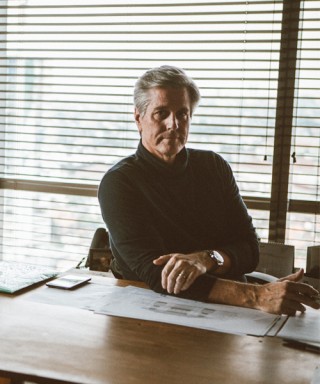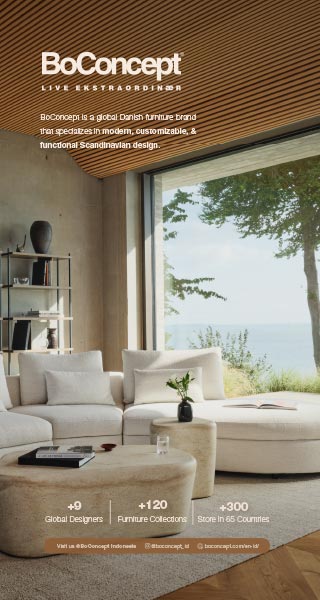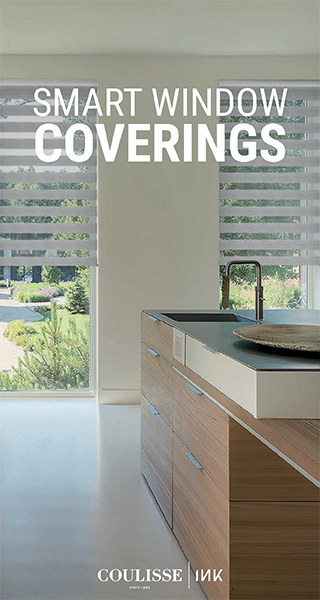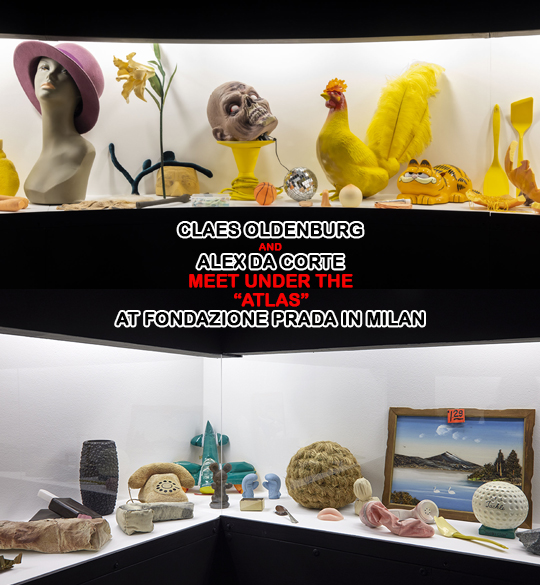
CLAES OLDENBURG AND ALEX DA CORTE MEET UNDER THE “ATLAS” AT FONDAZIONE PRADA IN MILAN
Published by Sugar & Cream, Thursday 18 September 2025
Images courtesy of Fondazione Prada
Two Generations, Two Visions, One Landmark Exhibition
Fondazione Prada will present Claes Oldenburg’s Mouse Museum (1965-1977) and Alex Da Corte’s Mouse Museum (Van Gogh Ear) (2022) to the public from 18 September 2025 (Press Preview on 17 September), on the eighth floor of the Torre, within its Milan venue, as part of the exhibition project “Atlas”. For the first time, the audience will have the opportunity to experience these two installations, strictly connected visually and conceptually, in the same space. Viewing the two “Mouse Museums” together offers a chance to reflect on the importance of both collecting and museum displays, artmaking and the self, while marveling at mass production, thus confronting different approaches to consumer culture.

Through solo presentations or unexpected comparisons between works created by international artists between 1967 and 2022, “Atlas” embodies a possible mapping of the ideas and visions that have contributed to the development of Fondazione Prada’s activities from 1993 to the present day. The project was conceived to evolve, one floor at a time, as part of an ongoing process, yet ready to incorporate new contributions from other artists or institutions. Its dynamic and evolving nature reflects Fondazione Prada’s desire to actively investigate how an exhibition space can be programmed and the role of a permanent project in a campus dedicated to contemporary culture.
On loan from mumok – Museum moderner Kunst Stiftung Ludwig Wien, Claes Oldenburg’s Mouse Museum merges the marvels of 1960s American mass production with the artist’s ironical, playful, and critical approach to art. Claes Oldenburg (Stockholm, 1929 – New York, 2022) began his artistic career in the mid-1950s, becoming a central figure in the emerging downtown New York art scene. Primarily working as a sculptor, experimenting with unconventional materials, he also created seminal environments and happenings, while later, through the collaboration with Coosje van Bruggen (Groningen, 1942 – Los Angeles, 2009), his oeuvre evolved in large-scale public projects worldwide, such as Ago, Filo e Nodo (2000) in Piazzale Cadorna, Milan.
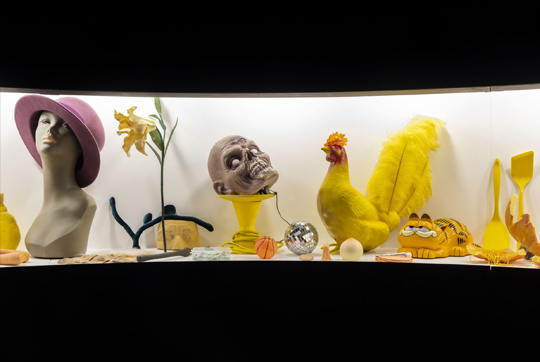
Alex Da Corte
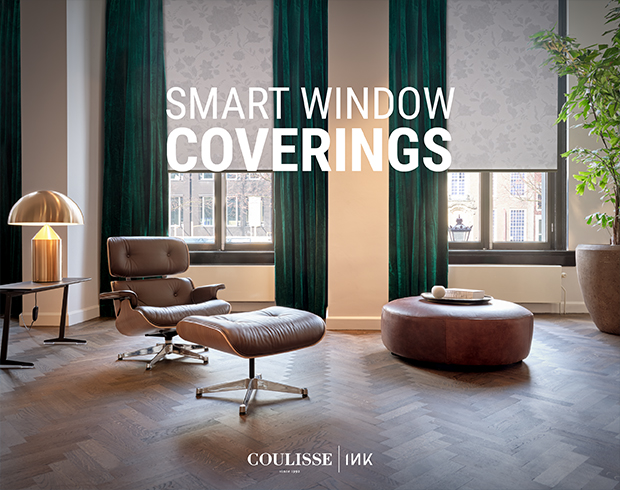
Presented by Coulisse | INK
Oldenburg began collecting mass-produced objects in the early 1960s, alongside small models and studies of his own work. This collection inspired him to house these items on a shelf in his apartment, which he titled in 1965 museum of popular art, n.y.c. In 1972, when invited to participate in Documenta 5 in Kassel, he developed the concept for a permanent museum named Mouse Museum. Its floor plan is based on the design of one of his works, Geometric Mouse — a fusion of Mickey Mouse’s head with the outline of an early movie camera or film projector. Inside the structure, Oldenburg arranged hundreds of objects without hierarchy or pedestals. These items are linked through a loosely associative sequence, guiding the viewer’s eye from one piece to the next via visual similarities and suggestive connections. The luminous band of the display cases unfurls like a film strip along the walls, collectively forming a portrait of the artist through the lens of consumer culture.
After its initial showing in 1972, Mouse Museum took its current shape and content following an exhibition at the Museum of Contemporary Art in Chicago in 1977. Between 2012 and 2014, the Mouse Museum travelled across major contemporary art institutions in the United States and Europe, including the Ludwig Museum in Köln, the Guggenheim Museum in Bilbao, MoMA in New York, and the Walker Art Centre in Minneapolis, and was exhibited for the last time at mumok in 2018.
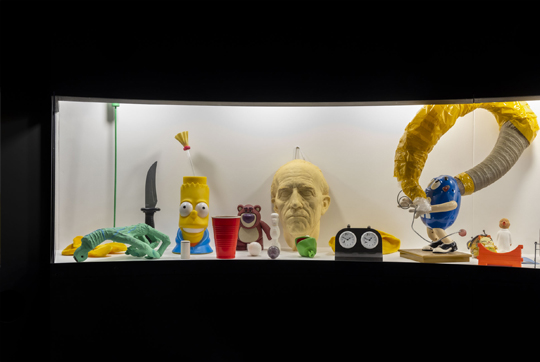
Alex Da Corte
Alex Da Corte (Camden, New Jersey, 1980) created Mouse Museum (Van Gogh Ear) in 2022 for his survey exhibition “Mr. Remember” on view at the Louisiana Museum in Humlebæk, Denmark. Though a clear homage to Oldenburg’s Mouse Museum, Da Corte gave an ironical and macabre twist to the installation by cutting off the left ear of the ‘mouse,’ hinting at the sadly famous episode of Vincent van Gogh’s life.
The structure, both inside and outside, is faithful in technique and arrangement to Oldenburg’s installation. The artist displays objects from his collection, among them a Harry Potter magic wand, a Bart Simpson thermos, kitchen utensils, a plastic beer pong cup, and a foam cast of Marcel Duchamp’s face. Merging popular culture and art history, the whole arrangement is conceived as a sort of self-portrait, offering an image of the artist’s desires and memories.
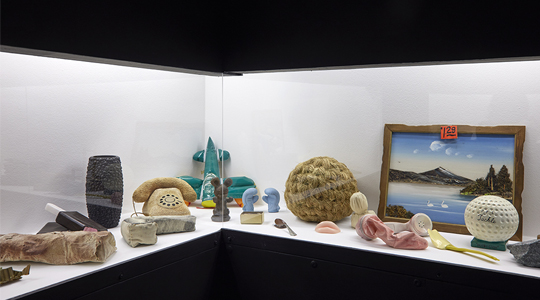
Claes Oldenburg
In his works, Da Corte explores contemporary life through videos, installations, paintings, and sculptures. With a focus on color and form, he connects popular and consumer culture sources with art history and modern design. Touching upon notions of identity, intimacy, and taste, his work reimagines the familiar in wholly unexpected ways. Da Corte recognizes Claes Oldenburg as an essential influence and reference for his practice, admiring his bold approach to popular, untouchable icons, such as Mickey Mouse, and his manipulation and transformation of everyday objects to create a personal mythology and self-representation. A site-specific video intervention titled Rubber Pencil Devil (2018) by Alex Da Corte was presented at Prada Rong Zhai in Shanghai in 2020.
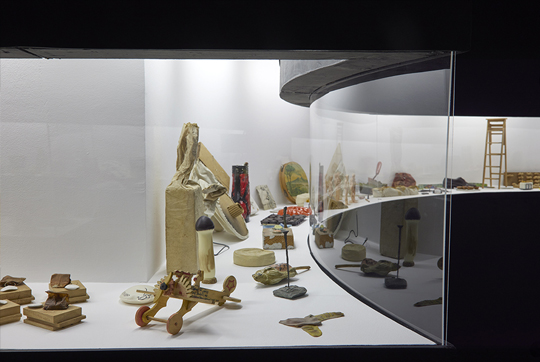
Claes Oldenburg
 3.22K
22/12/2025
3.22K
22/12/2025
TUMI HADIRKAN “GIFT JOY” UNTUK MUSIM LIBURAN
Temukan hadiah akhir tahun yang berkesan melalui koleksi TUMI, menghadirkan desain elegan dan craftmanship yang bertahan lama.
read more 120
22/12/2025
120
22/12/2025
YOSAFAT DWI KURNIAWAN — “TIME DILATION”
Yosafat Dwi Kurniawan’s “Time Dilation”: celebrating 15 years of craft through a modern reimagining of couture heritage.
read more 10.97K
03/12/2025
10.97K
03/12/2025
LIVING DIVANI ILLUMINATES THE FESTIVE SEASON IN SHADES OF DEEP RED AND LUMINOUS SILVER
Living Divani illuminates the festive season in shades of deep red and luminous silver, reimagining its iconic designs with festive radiance.”
read more 10.66K
26/11/2025
10.66K
26/11/2025
MOROSO AT ARTVERONA 2025: DESIGN AS DIALOGUE
Design as language – Moroso’s presence at the heart of ArtVerona’s 20th Edition
read more 81.47K
10/01/2025
81.47K
10/01/2025
W RESIDENCE IN SOUTH JAKARTA BY MICHAEL CHANDRA
Michael Chandra, founder of MNCO Studio Design has created the W Residence with an aesthetically pleasing, practical, and pleasant home from all...
read more 44.43K
11/07/2025
44.43K
11/07/2025
PELUNCURAN PERDANA LEGANO HOME MENGGANDENG AGAM RIADI DI ST REGIS RESIDENCE JAKARTA
Peluncuran perdana LEGANO HOME menggandeng Agam Riadi di St. Regis Residence Jakarta: menyatukan kemewahan dan jiwa dalam sebuah ruang.
read more




